
With the global video game market soon to be worth $200 billion it is safe to say that there has never been more competition for success. From bedroom-based solo developers to studios young and old, there are countless new games arriving across an ever-growing number of platforms.
While for a lot of people the idea of the typical “gamer” is still stuck in the 90s, the audience has grown well beyond its young male roots. As such, branding in the gaming space has largely moved from niche to pluralistic and inclusive.
But despite massive growth, for every popular break-through game in the industry, there are countless failures and clones. For every Candy Crush there are countless imitators. But as a maturing industry, game development studios (and investors) are looking for the bankability that comes from a powerful and enduring brand.
This shift is a huge part of why the industry is pivoting towards the “live service model” of gaming. For the uninitiated – that means games that are designed to be updated again and again in order to keep its audience engaged. If experience tells developers that it is going to take several failed attempts before creating a hit, studios want to maximize the lifespan of that product, and cash in the brand equity over a prolonged period of time.
This is why so many of the juggernaut brands in gaming have stuck around for so long. Many enduring brands such as FIFA, Fortnite and Minecraft have adopted the ‘evergreen design’ model in order to maximize engagement while minimizing the cost of developing a new game from scratch.
This essentially means making sure that a game (or a series) doesn’t become less interesting the more it is played – making sure that there is no specific end goal to reach, that there is a clear and ongoing experience for high-level players to enjoy in perpetuity. This is mirrored in the brand building itself, with the live service space having infinite possibilities for cultivating brand staying power in the long term. But this makes getting the foundational stuff right all the more important.
When building a brand in this live service model, brand appearance needs to take on some modern thinking. When designing a brand identity we have to think beyond product launch and build a framework that is future proof. For instance, rather than creating one game logo in a nutshell we need to think about how it will look with a series of future sub-brands. A live service game could end up with multiple expansions, seasonal events or store sales, and the branding should factor in how these future features could fit together. With so much visibility across the internet and beyond, consistency of brand materials is key and lack of a framework will hurt in the long-run.
Planning aside though, a well organized brand will still fall flat if it doesn’t stand out, and a bland look and feel will get ignored. Fall Guys is a great example of a brand with framework and impact. Bright, high contrast colors to stand out on storefronts with artwork that epitomizes their tone of voice. The characters themselves with their jelly bean simplicity make them so easy to replicate. This opened the door for short term boosts in the form of in-game outfit / skin sales but more importantly larger brand crossover deals, where characters from other franchises could be built in the same style. This level of forethought in the design has paid off enormously long-term.
This brings us to another component of “brand building” in the modern gaming space – franchising. Having components that exist outside of the core game itself can transform a successful game into something timeless. Esports leagues, live events and of course – merchandising reaches a wider audience which in-turn can feed back into the game. Case and point – Pokemon did not become the world’s most successful franchise based on game sales alone.
So for those looking to maintain or establish enduring brands in the modern live service gaming space, it is undoubtedly a challenge. For every one that succeeds there are still dozens that don’t. There are lessons to be learnt to improve the chance of success. A reputation doesn’t appear overnight but with an involved community advocating for you, it can grow quickly. Combine that with high impact design, a good framework to build on and the right timing, and the opportunity to build something that lasts is there for the taking.
Cover image source: Sean Do